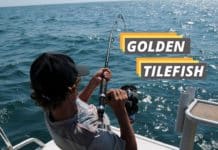How many types of trout do you know? And from these species, how many can you correctly identify? The USA is home to over ten trout species. Does that surprise you? If yes, this article will walk you through the 14 different types of trout species.
We have categorized these species into native, invasive, and hybrid. And, as a bonus, we take a closer look if char is a trout or a salmon.
Let’s dive in.
Native Types of Trout Species
These trout species are from the United States, and their existence has dramatically contributed to a natural and healthy ecosystem over the years. The native trout species include Gila trout, Apache trout, Rainbow trout, Cutthroat trout, and Golden trout.
Gila Trout
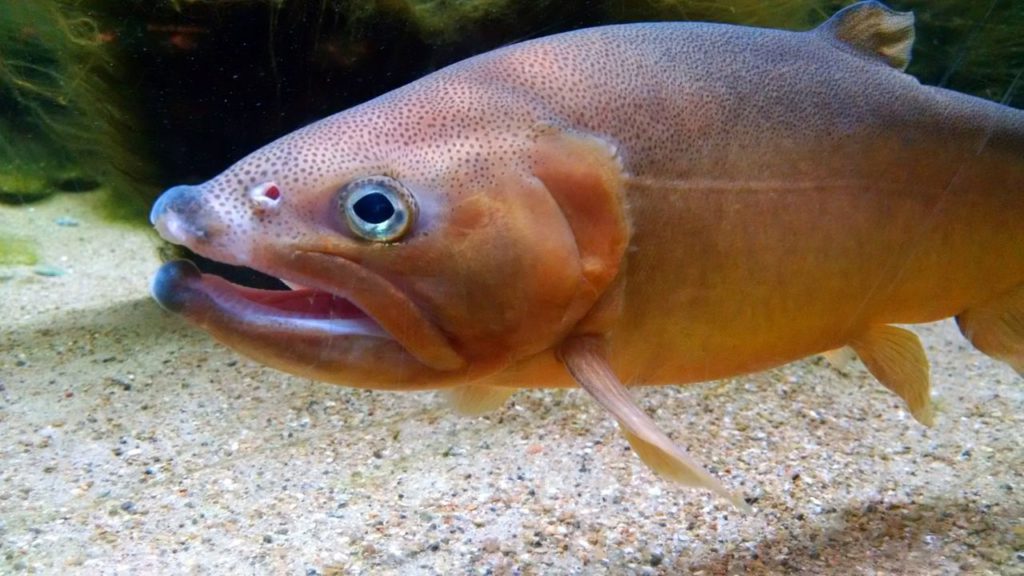
| Scientific name | Oncorhynchus gilae |
| Other names | None |
| Appearance | Iridescent gold color |
| Average weight and length | 1 to 6 oz., 5 to 9 inches |
| Habitat | Creeks, perennial montane streams |
| Range | New Mexico, Arizona, San Francisco |
| Conservation status | Threatened species |
You can identify a Gila trout from its yellowish or golden-colored sides with small, black spots. Their gill plates have dark-copper color, while the fins have a white or yellowish tip.
These fish thrive in cold waters found at high elevations. You can find them in perennial streams over 5,400 feet with temperatures under 77 degrees Fahrenheit.
Gila trout are a rare trout species native to the Gila River drainage. Unfortunately, the species almost went extinct due to human development, overharvesting, wildfires, and water diversion. By 1967, it was listed as an endangered species.
Fortunately, conservation efforts have helped restore the populations over the years. The fish is currently listed as a threatened species.
Apache Trout
| Scientific name | Oncorhynchus apache |
| Other names | Behnke, Yellow belly, Arizona trout |
| Appearance | Golden yellow, olive-yellow, and olive-brown colors with dark uniform spots. |
| Average weight and length | 3 to 6 pounds, 12 to 23 inches |
| Habitat | Cold, aerated water |
| Range | Arizona |
| Conservation status | Threatened species |
The Apache trout is commonly referred to as Arizona trout because it is native to the state. The fish live in cold forest streams and mountain lakes with high oxygen levels.
The trout has an olive-yellow body with uniform dark spots. Their average length is 12 inches but can get to 20 inches.
To catch apache trout, use dry flies, salmon eggs, nymphs, and worms as bait. Additionally, use spinners and spoons to improve your fishing success.
Apache trout almost went extinct from wildfires, overfishing, and invasion of non-native trout. However, efforts to restore the population have proved successful; they are now classified as threatened.
Rainbow Trout
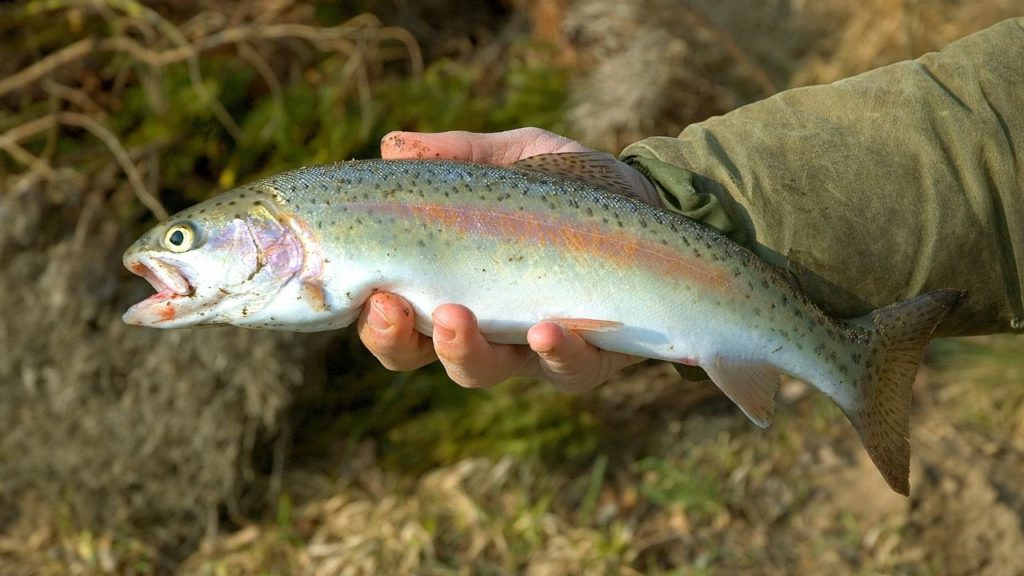
| Scientific name | Oncorhynchus mykiss |
| Other names | Redband trout, steelheads, steelhead trout |
| Appearance | Blue-green, yellow-green body, white belly, pink sides, black spots on the back |
| Average weight and length | 2 to 16 pounds, 20 to 30 inches |
| Habitat | Cold, clear water |
| Range | East of Russia, Western North America, Northern Pacific Ocean |
| Conservation status | Threatened species |
These trout do not resemble the rainbow, but they have beautiful colors. They are yellow-green or blue-green with a white underbelly, pink stripes on the side, and black spots on their fins and black.
The juveniles live in cool, clear waters feeding mainly on surface insects, invertebrates, and small fish. They then migrate to sea or ocean waters and only return to freshwater during the spawning season.
Steelheads grow to weigh up to 16 pounds, which is an excellent catch for any angler. The best time to catch rainbow trout is late spring. Carry an ultra-light rod and reel as these fish always put up a fight.
Cutthroat Trout
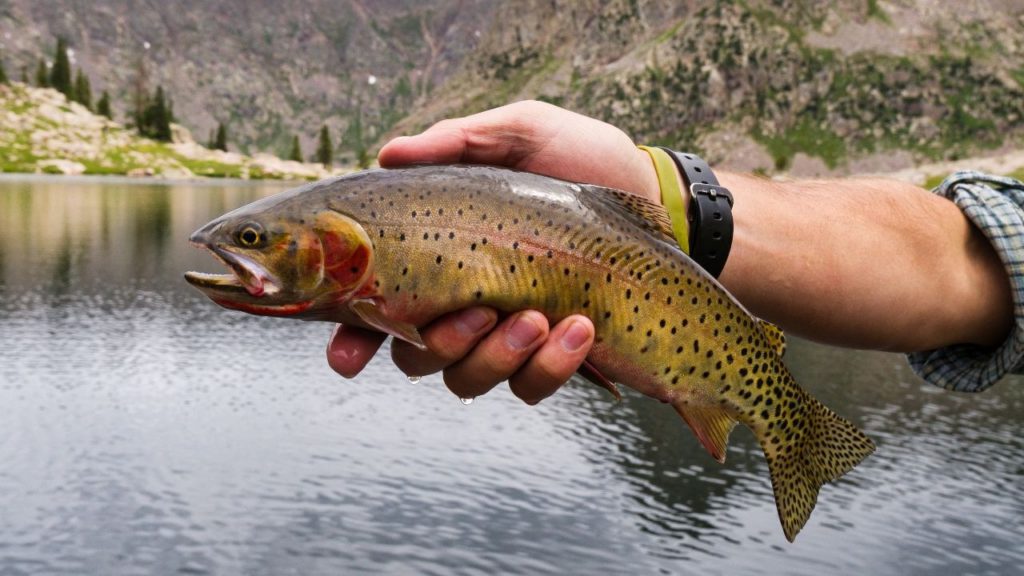
| Scientific name | Oncorhynchus clarkia |
| Other names | Salmo clarki |
| Appearance | Brassy color with spots, forked tails |
| Average weight and length | 2 to 17 pounds, 6 to 40 inches |
| Habitat | Coldwater tributaries |
| Range | Hudson Bay, Rocky Mountains, Mississippi, Pacific Coast |
| Conservation status | Threatened species |
These trout have a distinctive red streak on their lower jaw hence the name. This fish can have a green, gray, or golden body with orange, pink, or red marks depending on the species.
They live in cold, freshwater, or seawater. The best fishing time for sea-run cutthroat is during spring or fall. But regardless of the species’ habitat, these fish are visual hunters and aggressive bottom feeders who will try any lure.
These fish are sensitive to water quality and almost went extinct. Some species like the Greenback cutthroat trout are still a threatened species.
Golden Trout
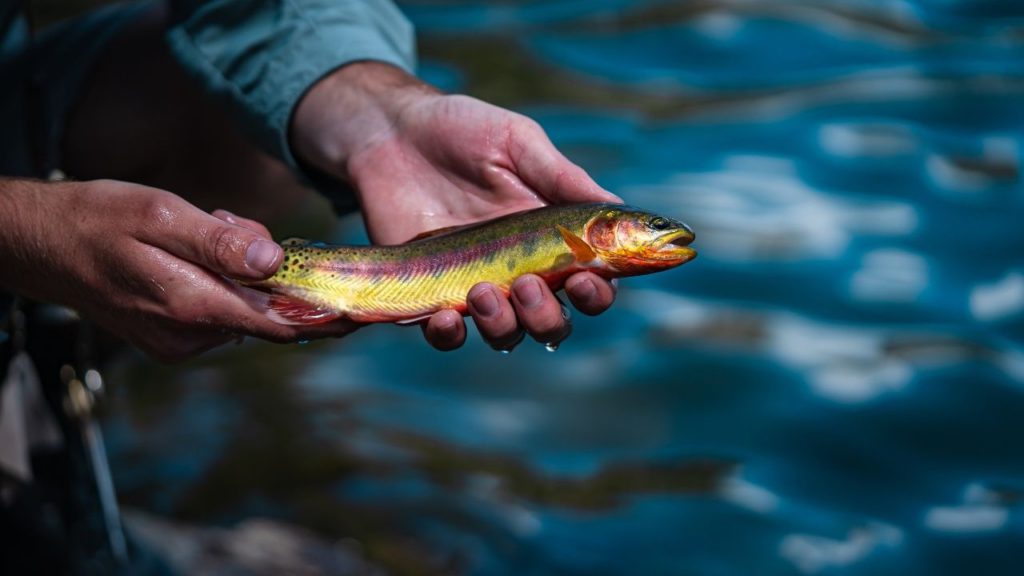
| Scientific name | Oncorhynchus aguabonita |
| Other names | California golden trout |
| Appearance | Yellow-gold flanks, red band on lateral line, copper backs, parr marks, oval marks, deep-red bellies |
| Average weight and length | 0.5 to 1.25 pounds, 6 to 12 inches |
| Habitat | Cold, clear, high-altitude streams |
| Range | Nevada mountains, California |
| Conservation status | Threatened species |
California is home to the golden trout. It has a close relationship to Kern river rainbow trout and little kern golden trout. Together, this trio is called the “golden trout complex.”
Did you know Golden trout have a lifespan of 7-9 years? These fish live in high-altitude rivers and streams at 7000 to 12000 feet. They enjoy that the clear, cold waters here have less vegetation since their diet consists of larvae, small insects, and crustaceans.
Invasive Types of Trout
Although imported trout species initially contributed to a healthier aquatic environment, some, later on, became invasive. They disrupt the balance up to the point that they are over competing with native types of trouts.
Brown Trout
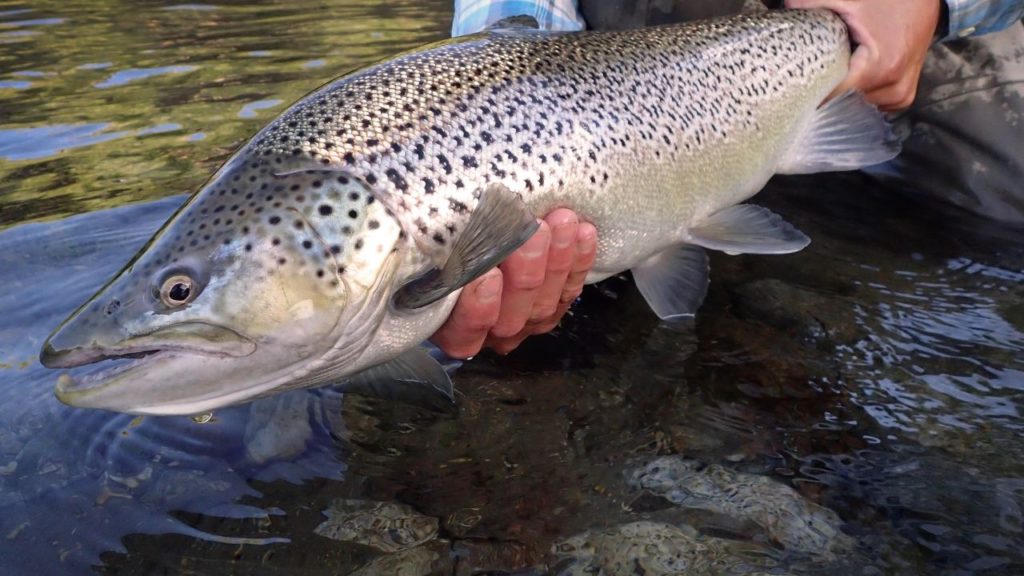
| Scientific name | Salmo trutta |
| Other names | German brown, sea trout |
| Appearance | Golden, yellow-brown body, red and black spots |
| Average weight and length | 2.5 to 10 pounds, 14 to 24 inches |
| Habitat | Coldwater |
| Range | Iceland, almost all US states |
| Conservation status | Least concern |
The brown trout is native to North Africa, Western Asia, and Europe. The breed was introduced to the US from Germany and the UK in the mid-1860s.
Brown trout can weigh up to 10 pounds. If you want to catch some of these opportunistic feeders, prepare your fishing gear during spring or fall. This is the best time for show casting with spinners, spoons, worms, dry flies, and minnows. Alternatively, try still fishing, trolling, and casting in the summer.
Hybrid Trout Species
Hybrid trout species result from crossbreeding two or more different types of trout. Unfortunately, finding this type of trout in the wild is rare since they are produced in hatcheries. Cuttbow, however, is an exception.
Palomino Trout
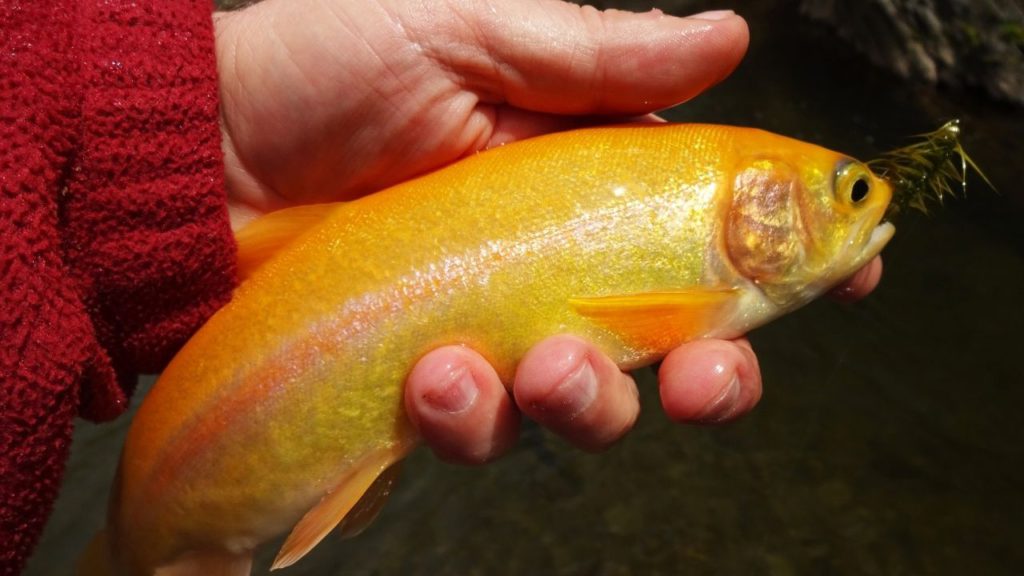
| Scientific name | Oncorhynchus mykiss |
| Other names | Banana trout, lightning trout, albino rainbow trout |
| Appearance | Yellow body, red stripe on the centerline, no dark spots |
| Average weight and length | 2 to 10 pounds, 12 to 30 inches |
| Habitat | Fast-moving streams, mountainous regions |
| Range | Water bodies around fish hatcheries |
| Conservation status | Least concern |
The Palomino trout is the result of breeding Rainbow trout with the West Virginia golden trout. The hybrid is bred in hatcheries and then released into the ponds and lakes to entice anglers to make a rare, prized catch.
The largest concentration of Palomino trout is in California. However, spotting the fish in the wild is much easier than catching one. The breed is picky and rarely tries to eat the bait off the fishing line. Moreover, they never go down without a fight.
Patience is essential when fishing these rare fish. Other helpful tips include fishing early, downsizing your bait, and if you are unsuccessful come midday, avoid shadow casting.
Splake
| Scientific name | Salvelinus fontinalis X Salvelinus namaycush |
| Other names | Speckled trout |
| Appearance | A mix of lake trout and brook trout |
| Average weight and length | 2 to 7 pounds, 8 to 18 inches |
| Habitat | Coldwater |
| Range | Great lakes |
| Conservation status | Least concern |
Splake is the offspring of the Lake trout and Brook trout. You may have difficulty identifying this species since it takes after its parents. The sure way to ascertain a fish is a splake is by counting the pyloric ceca. Splake has 65 to 85, which is less than Lake trout and more than Brook trout.
This hybrid species can reproduce and has been crossbred in hatcheries with its parent species. However, there is no proof of the splake reproducing in the wild. Despite this, the species has a spawning run during fall.
Tiger Trout
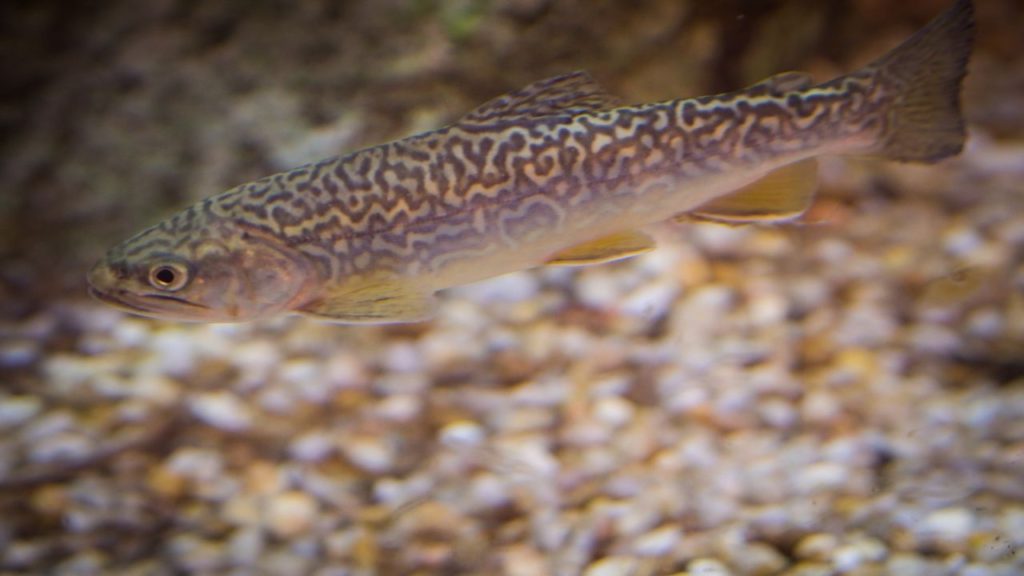
| Scientific name | Salmo trutta X Salvelinas fontinalis |
| Other names | None |
| Appearance | Maze patterns, brownish-gray body |
| Average weight and length | 2 to 5 pounds, 10 to 20 inches |
| Habitat | Cold, well-oxygenated water |
| Range | West of United States |
| Conservation status | Least concern |
The tiger trout bears tiger-like markings that resemble maze patterns. The breed is a crossbreed between a male brook with a female brown trout. Most tiger trout populations are produced in hatcheries and then stocked in the wild.
The species is sterile because it is developed from a triploid egg. This means the fish has three pairs of chromosomes instead of two. The extra pair makes it impossible to reproduce.
You can catch tiger trout with artificial flies, bait, spoons, and small spinners. Georgia, Colorado, Pennsylvania, Idaho, and Washington are some states that stock this fish.
Cut-Bow Trout
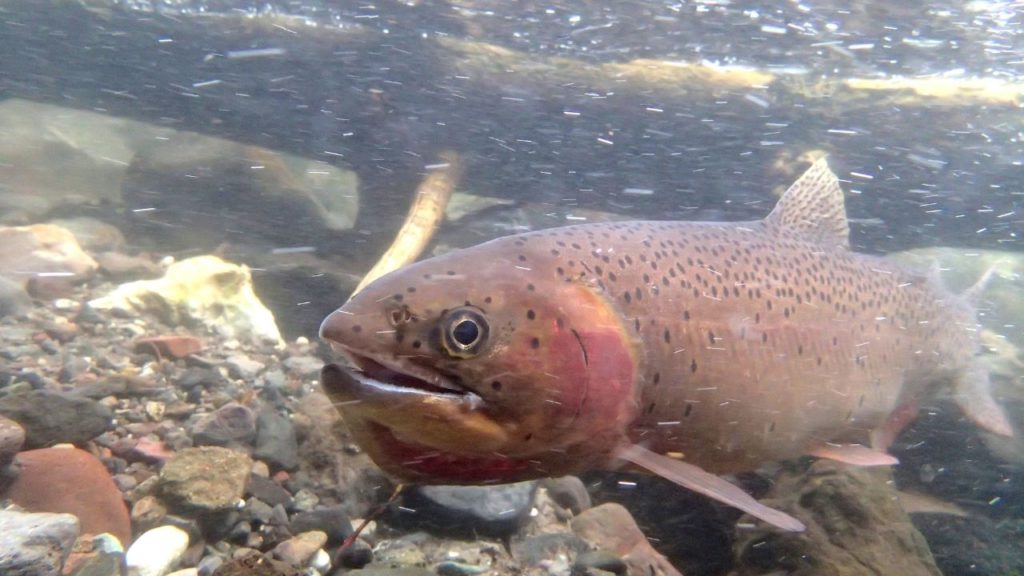
| Scientific name | Oncorhynchus clarkia X Oncorhynchus mykiss |
| Other names | None |
| Appearance | Characteristics of both parents, red/orange markings on the jaw, slash under the gills |
| Average weight and length | 1 to 8 pounds, 12 to 24 inches |
| Habitat | Cold, freshwater environment |
| Range | Western states of the USA |
| Conservation status | Least concern |
Cutthroat and rainbow trout have similar spawning seasons and require identical water conditions. This usually leads to the species overlapping with a male rainbow trout fertilizing the eggs of a cutthroat.
The unique fertilization produces a natural hybrid and fertile cut bow trout. These fish resemble each of their parents, but you can tell them apart from the red/orange slash marks under their gills.
Cuttbow spawn in natural habitats or hatcheries during spring.
Char
Unknown to many, char and trout belong to the same family – Salmonidae. But, char has a unique genus (Salvelinus) that makes them a circumpolar species. These fish are adapted to living in extremely high altitudes and are native to the Arctic. They feature light spots on their dark bodies.
Dolly Varden Trout
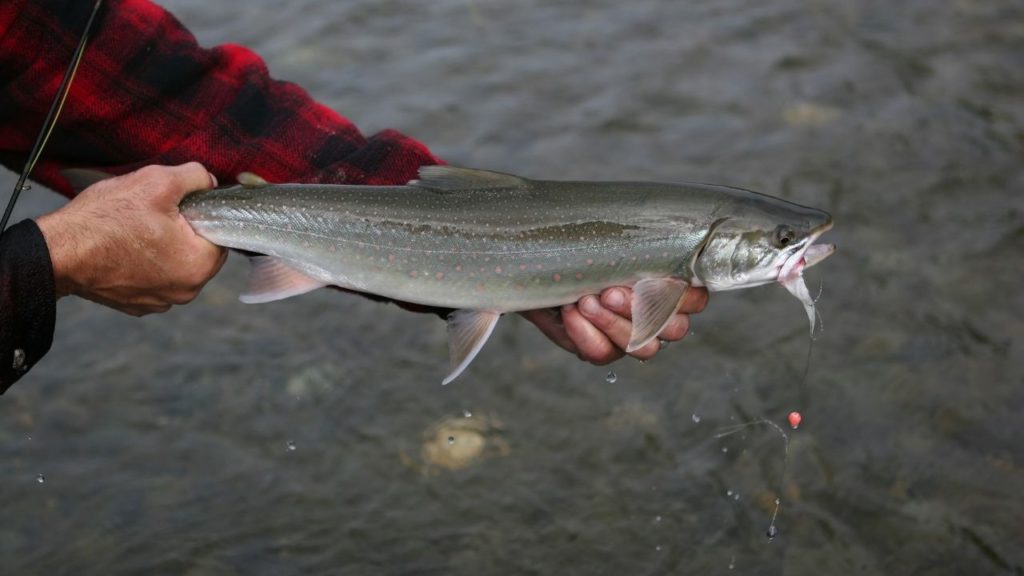
| Scientific name | Salvelinus malma |
| Other names | Malma |
| Appearance | Bluish, silvery, olive-green silver-gray |
| Average weight and length | Up to 27 pounds, 16 to 22 inches |
| Habitat | Coldwater tributaries, freshwater, saltwater |
| Range | North America, Alaska |
| Conservation status | Least concern |
Many anglers confuse Dolly Varden with the bull trout. Although they resemble one another, Dolly Varden is much smaller and lives close to the coast, while bull trout are larger and live inland.
This species can live in freshwater, brackish water, and oceans. A while back, dolly Varden was considered a nuisance since they preyed on other species’ eggs. Today, they are beauty and prize among fly fishers.
The best fishing time for dolly Varden is during spring and early summer.
Bull Trout
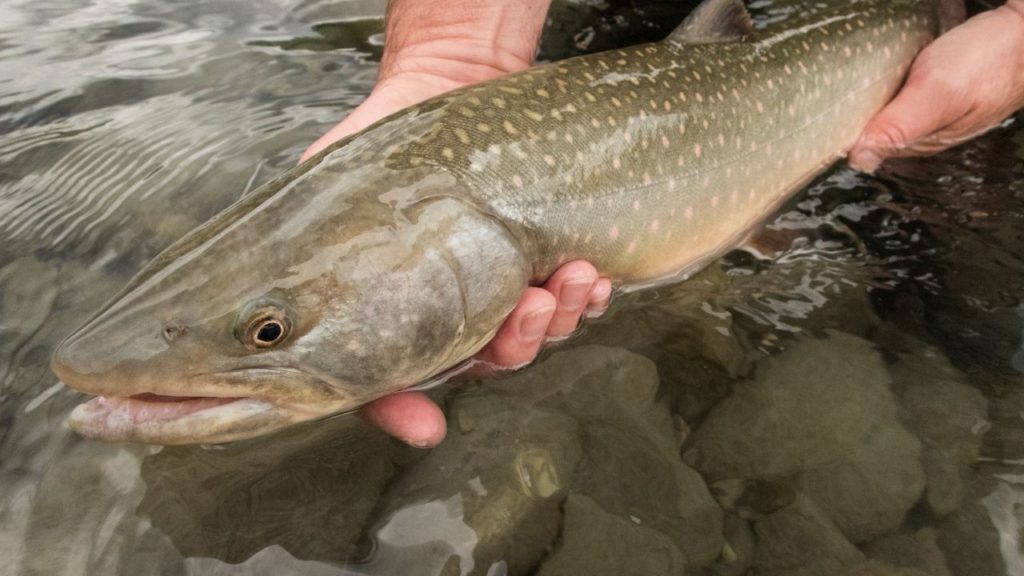
| Scientific name | Salvelinus confluentus |
| Other names | Inland Dolly Varden |
| Appearance | Orange, yellow, red, or pink spots, olive or blue-gray body |
| Average weight and length | 30 pounds, 37 inches |
| Habitat | Clean, cold water |
| Range | Western Canada, Northwest USA |
| Conservation status | Vulnerable |
Bull trout have bigger heads than their body, and they are always fighting when they are reeled in, hence the name.
This species prefers the cold waters in the high mountains or the coastal region. However, the cold temperatures affect their reproduction. Unlike other types of trout, bull trout do not spawn every season. Bull trout are currently listed as a threatened species.
Lake Trout
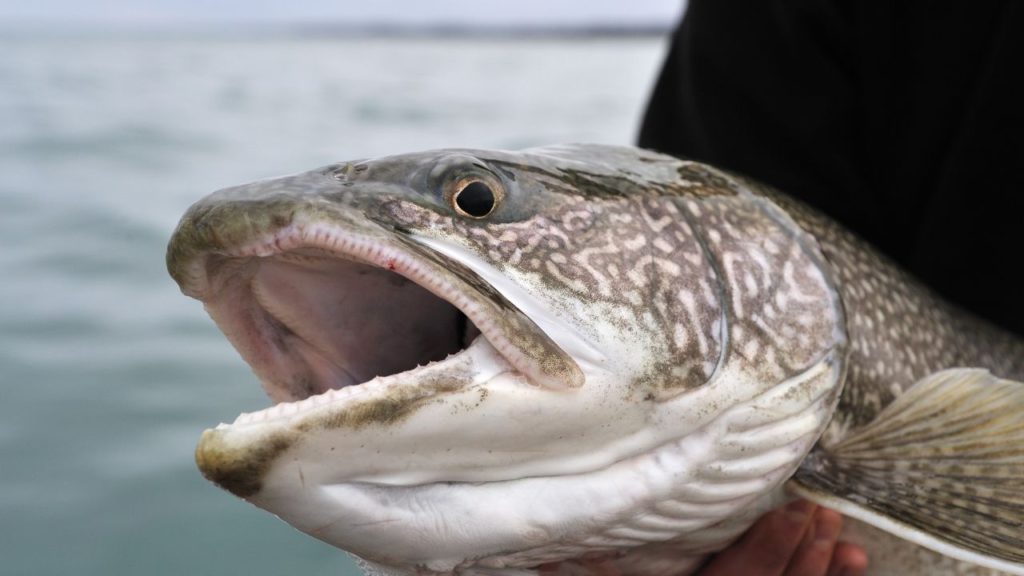
| Scientific name | Salvelinus namaycush |
| Other names | Mackinaw trout, Salmon trout, Great lakes trout, Lake char |
| Appearance | Dark-green, olive, gray, brown colors, silvery sides |
| Average weight and length | 15 to 40 pounds, 20 to 30 inches |
| Habitat | Deep, cold, and freshwater environs |
| Range | Alaska, North America |
| Conservation status | Not yet evaluated |
Did you know lake trout can live for 20-25 years? The oldest recorded lake trout was 62 years old. Thanks to this long lifespan, these fish have an average weight of 40 pounds. Still, there have been cases where the breed exceeded 100 pounds!
The breed is currently threatened by overexploitation and sea lamprey. However, restoration plans are underway to increase the population.
Brook Trout

| Scientific name | Salvelinus fontinalis |
| Other names | Eastern brook trout, brook charr, speckled trout, brookie, mud trout, squaretail, coaster trout |
| Appearance | Olive-green color, yellow spots, streamlined body |
| Average weight and length | 1 to 6 pounds, 10 to 26 inches |
| Habitat | High elevation, heavy forests |
| Range | Eastern North America, Canada, Alaska |
| Conservation status | Not listed |
Brook trout thrive in icy water. They are too sensitive to water changes, and their populations decrease when exposed to water pollution.
The species feeds on insects and small fish. If you are interested in catching the speckled trout, plan your fishing trip around dawn or dusk. They retreat and hide during the day, only to become active at sunrise and sunset.
These trout spawn during fall and have a lifespan of two to three years.
Types of Trout: Wrapping It Up
Now you know the 14 types of trout species you can find in streams, lakes, or creeks. Each species is unique, whether native, hybrid, or invasive. How many types of trout have you encountered so far? We’d love to hear from you in the comment section below!
Table of Contents


